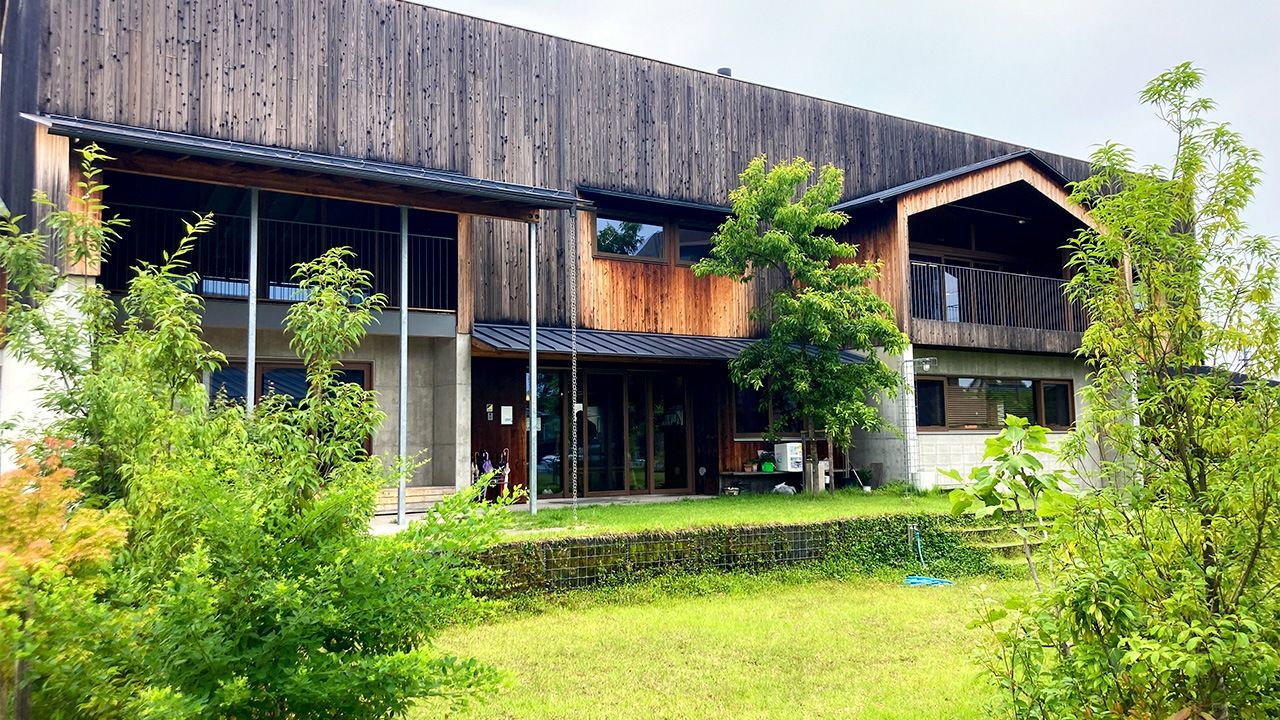
The Joy of Eating at the Kagayaki Home Care Clinic
Society Health Lifestyle- English
- 日本語
- 简体字
- 繁體字
- Français
- Español
- العربية
- Русский
Kagayaki Lodge is a warm-looking wood-framed building standing on a lush lawn atop a hill in the Gifu Prefecture town of Ginan. The spacious and open atmosphere surrounding the facility almost makes it look like a country guest house. However, it is the home base for staff from a clinic that provides medical care at home for patients who have difficulty enduring trips to and from a hospital. Nearly a dozen vehicles are lined up behind the building in preparation for visits to patients’ homes.
Also on the premises is Kagayaki Camp, a rehabilitation center where severely mentally or physically handicapped children can stay before beginning school.
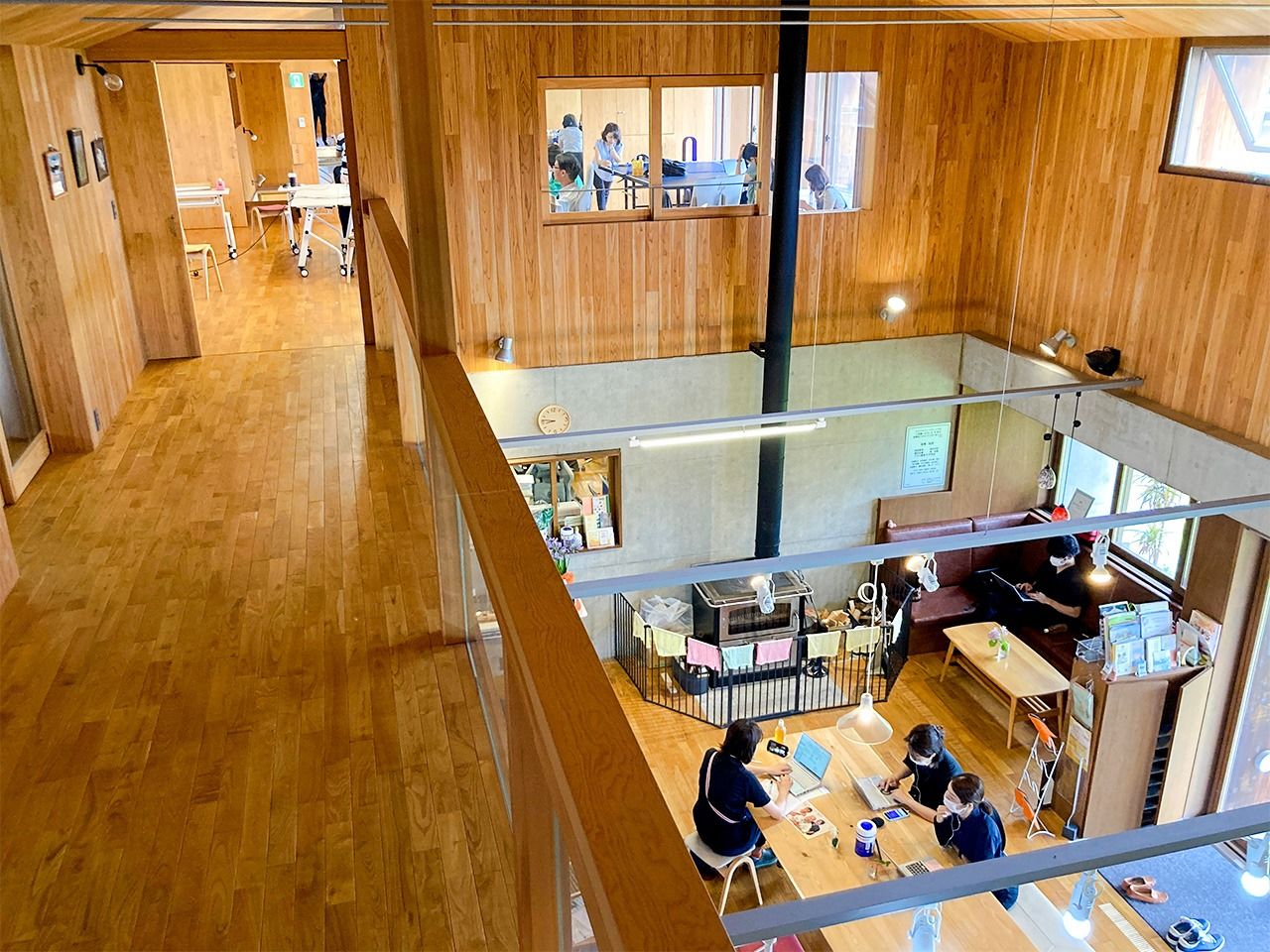
Staff members hold meetings before performing their assigned duties. Because of the atrium and few walls separating the workspace, the different groups are all loosely connected. (© Daidō Atsushi)
In June 2023, staff from Chimei Medical Center in Tainan, Taiwan, visited Kagayaki with employees of Chimei Frozen Food. The group, with 11 members in all, included a dietitian, speech therapist, dentist, and dental hygienist. Their training at the facility was focused on what Kagayaki calls shokuraku, or “eating enjoyment,” and the group learned techniques and approaches to help patients who have difficulty eating to continue enjoying dining. As the interpreter for the Chimei group, I would like to share my experiences of the visit and what it says about the role of food and health in an aging society.
At the welcome party on the first day of training, Ichihashi Ryōichi, the president of Kagayaki, gave a lecture titled “No Food, No Life!”
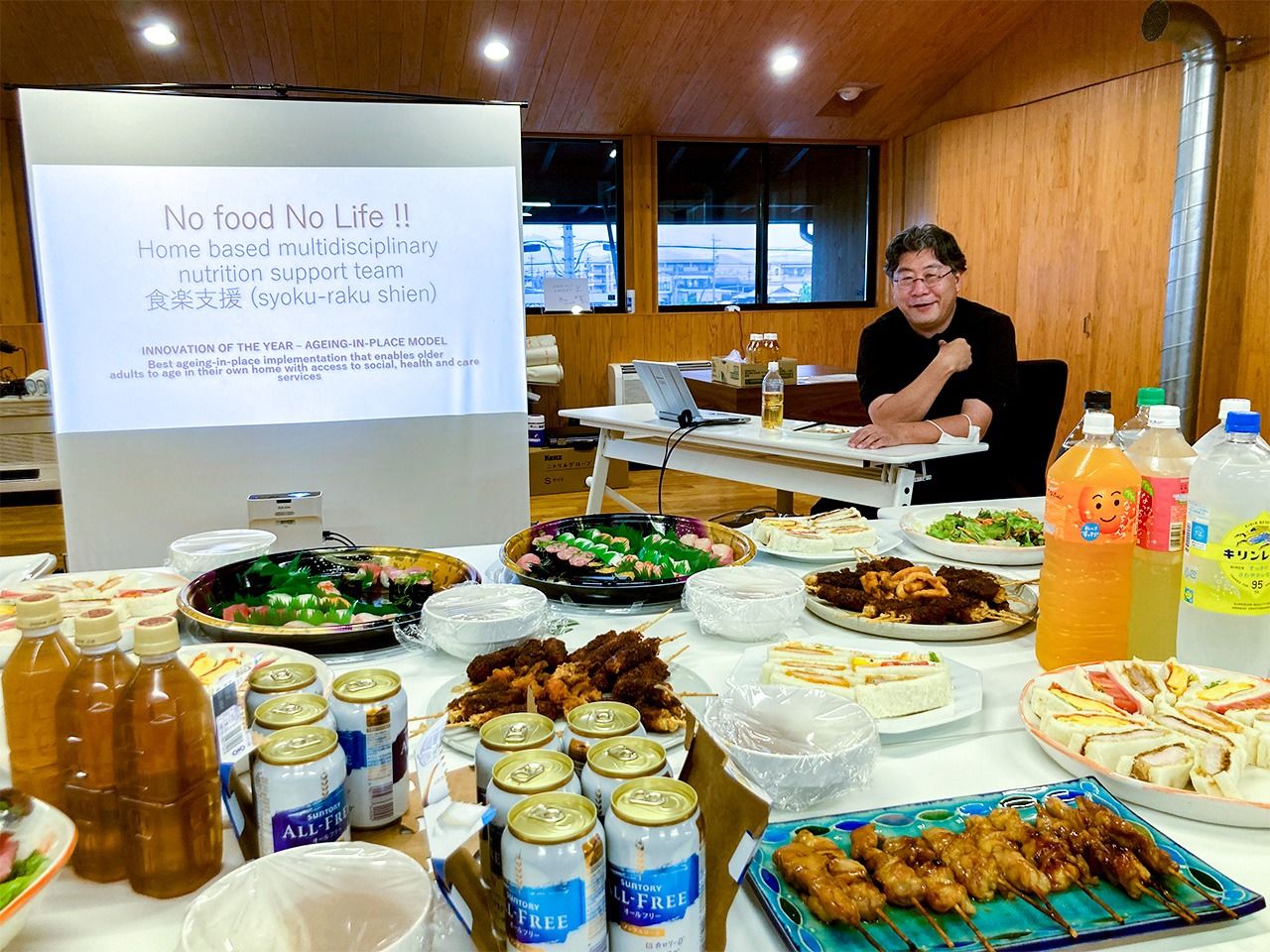
Ichihashi gave his lecture, appropriately enough, over a feast of sushi and yakitori. (© Daidō Atsushi)
As I struggled to translate unfamiliar terminology, the title of the lecture nevertheless made me recall my own family’s faces. It has been more than 11 years since I moved to Taiwan. On my occasional visits home to Japan, I always treasured the time feasting and talking with my family. After all, eating is more than just satisfying our appetite and ensuring that our bodies continue to function—it is also an important time for communicating, connecting, and filling our souls. If mealtimes were lost, how dull would our daily lives become?
However, everyone ages, and anyone can suddenly become ill. We may all at some point lose the simple ability to put food in our mouths.
The Morning Meeting: The Basis of Coordination
Each day at 8:30 in the morning, the Kagayaki staff kicks off activities with an online meeting. Divided into groups based on location, the staff check patient charts, receive reports from doctors and duty nurses on the events of the previous evening, and look over the status of patients scheduled to be visited, while also paying attention to those who are not on the visit roster for the time.
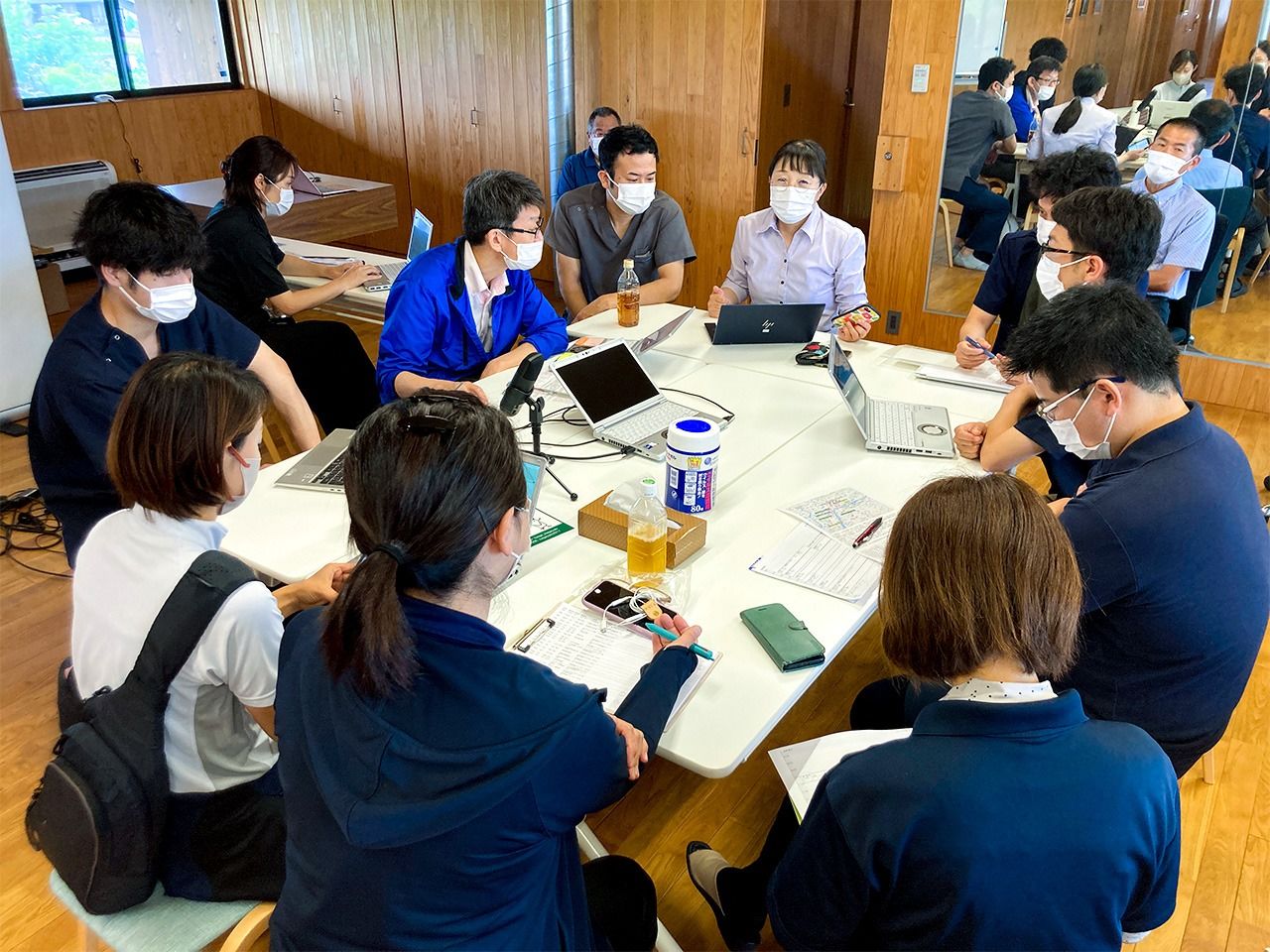
A morning meeting at Kagayaki. (© Daidō Atsushi)
An impressive range of medical and administrative staff share information at these meetings and discuss the best courses of action for the visits and ways to put the patients at ease. There are general practitioners, surgeons, dentists, urologists, dermatologists, nurses, physical therapists, dietitians, dental hygienists, music therapists, palliative care providers, and internal medicine experts.
At one meeting, a staff member announces that one care recipient has passed away, somberly recounting the situation prior to the patient’s entry into home care up until the end. There is a moment of silence and mourning, and then the next report is made. Kagayaki supports about 600 patients a year, and about 200 will pass away during any given year.
The Mouth: The Source of Vitality
After an hour-long meeting, staff members head to the homes of the patients they are responsible for. Our group visits a 96-year-old man. The man is well-built, bright, and speaks cheerfully while sitting on a bed at the back of tasteful traditional Japanese style house. When I told him that I was here from Taiwan on a study tour, he shared with me, “My uncle used to work in the Taiwan Governor-General’s office during the Japanese occupation, and he built railways.”
About a year and a half ago, this man began receiving care from Kagayaki after a referral. I was shown a picture of him at that time and was shocked. He was as thin as a matchstick and was lying helplessly on the bed. He now seems like a completely different person.
After his entry into the program, a dentist and dental hygienist immediately began to provide oral health care. After being fitted with false teeth that fit him perfectly, his appetite returned. He kept snacks in a bag hanging by his bed so that he could reach them whenever he wanted. His weight is now up to 54 kilograms, and he is even thinking about measures to control weight gain. This grandfather has regained his energy and is even trying to walk on his own.
Visiting staff members gain all the necessary information through conversations with the patient, family members, and day service staff. These visits are usually coordinated with other medical and welfare agencies to reduce the burden on the patient. At the end of a visit, data is entered immediately into the clinic’s information management system from a computer, and guidance notes are printed out and given to the family before the professionals leave the home.
On another day, I witness a dental visit. Saliva is collected and a machine is used to measure the quantity of bacteria. The mouth is then cleaned with a sponge. As the denture was slightly misaligned, the dentist fine tunes it on the spot. The patient’s face and neck area are massaged, bringing a happy comment: “That feels really good.” This attention to the patient’s comfort left a strong impression on me.
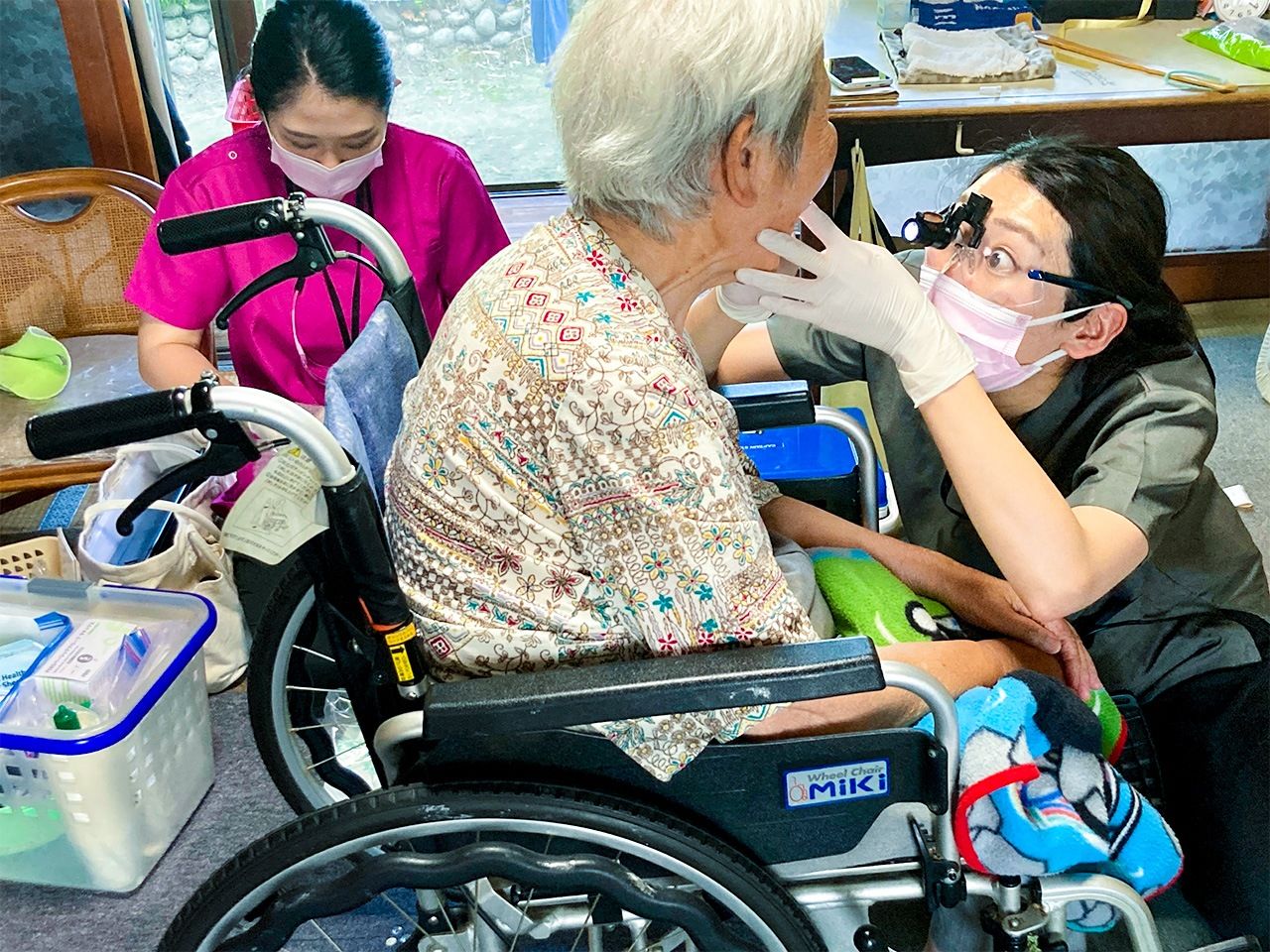
A dental consultation visit. (© Daidō Atsushi)
The dentist from Chimei Medical Center looks on enviously. In Taiwan, house calls by dentists are not widespread and there is no national certification for hygienists.
A dental hygienist shares with us the importance of dental hygiene for the elderly: “When bacteria, especially candida, proliferate in the mouth, it causes pain in the tongue and a loss of taste. This in turn causes a loss of appetite, reduced food intake, and ultimately a loss of strength. Just by cleaning the mouth, we can reverse this process, and the patient regains strength.”
Vitality truly starts with the mouth.
Cooking Practices for Patients with Dysphagia
Kagayaki’s shokuraku approach is implemented to achieve two goals: to help patients enjoy eating, but also to help their families more easily prepare food suitable for those patients.
When patients are unable to put food in their mouth, chew, and swallow due to the aging process, a stroke, dementia, or a neuromuscular disease, they are considered to have dysphagia. A patient may have to be fed through a nasal gastric tube or a PEG tube connected directly to the stomach.
Even if the level of dysphagia does not require a tube, patients may still need softened food or food mixed into a thick paste. However, this places a burden on families and presents the risk of aspiration, or the inhalation of fluid while imbibing food and water. In this case, the patient may not always want to eat or be able to obtain sufficient nutrition from a soft food diet.
To reduce the burdens of preparation and anxieties around eating for these patients and their families, the Kagayaki staff have developed various cooking and preparation methods. They demonstrate these to us in their kitchen. Menu items included rice porridge, grilled chicken, ramen noodles, and fruit jelly.
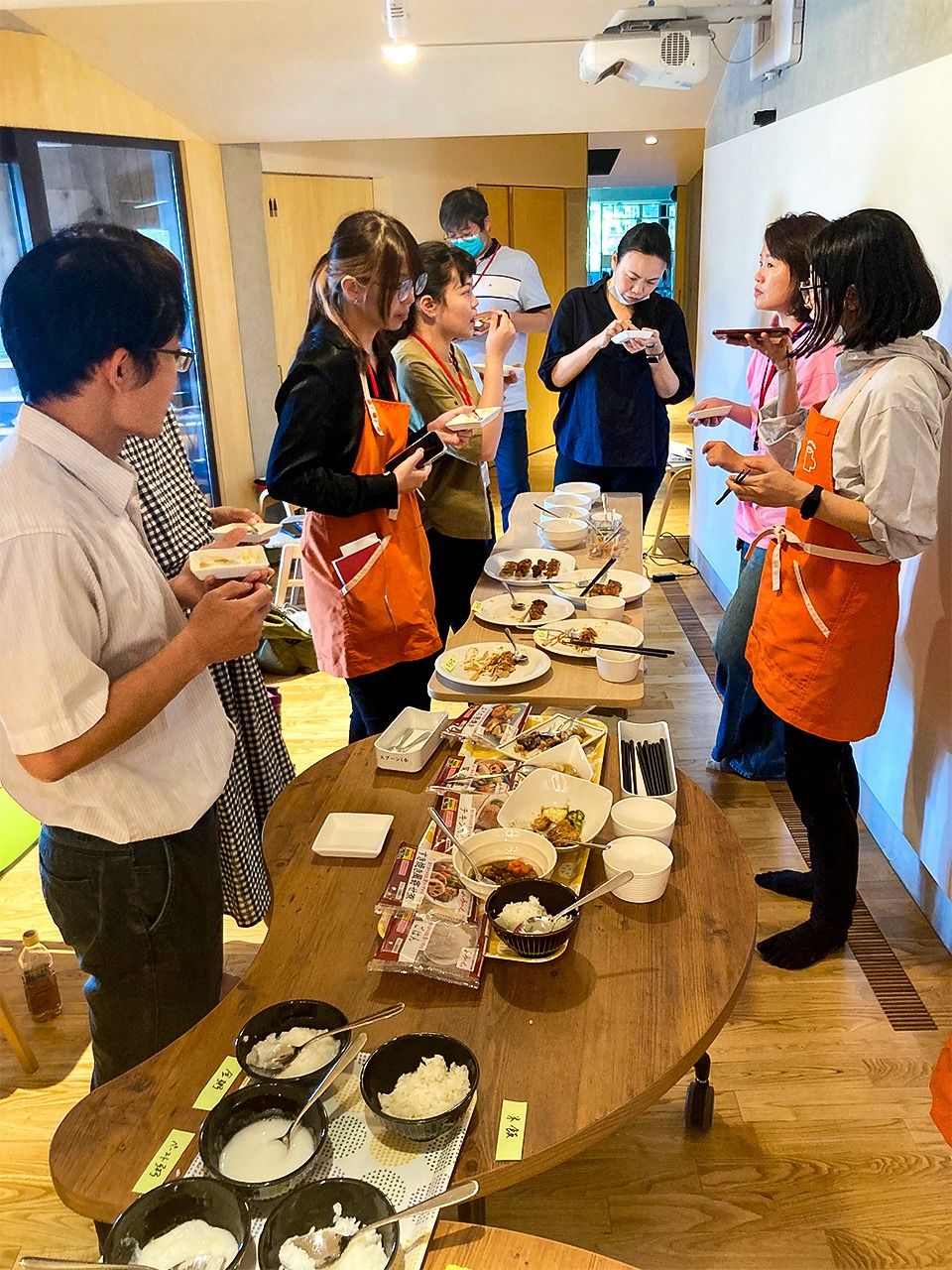
Participants exchange opinions after tasting Kagayaki’s creations during the cooking demonstration. (© Daidō Atsushi)
The Kagayaki staff, for example, tell us that “when you add water to food to make it into a paste, you essentially lose half of the nutritional value from the meal. If you make paste using rice porridge instead, you get the nutrients from the rice porridge at the same time.”
One notable creation was the yakitori or grilled chicken. Depending on the level of dysphagia, porridge or soft-cooked rice is milled into a paste and reformed with chicken into a chickenlike shape, skewered, and coated with sauce. For the finishing touch—and the key to enjoyment—the skewers are grilled over a burner. The savory smell also stimulates the appetite.
The Educational “Eat Card” Game
People have different values concerning food that Kagayaki staff are always careful to respect. They play a game developed in-house called the “Eat Card” game. The game uses 40 cards containing phrases such as “I want to eat what I want until the end of my life,” “I don’t want a gastric tube,” or “I don’t want to be forced to eat.” The game is played by people of different ages and backgrounds. Game participants turn over cards according to certain rules based on a hypothetical age and medical condition that they are assigned. In the end, each player is left with five cards that match their own values. They then present and discuss with others the cards that they have relative to their hypothetical condition.
Addressing the Hope-Anxiety Dilemma
Kagayaki’s philosophy is to “support people to live the life they want to live at home together with peace of mind.” However, with hope for a comfortable life often comes anxiety for both the patient and their families. Aspiration pneumonia, financial burdens, sudden changes in condition, and whether a family member can be around at a given time are just some of the common challenges. Many sad incidents have been reported in the media that are likely the result of caregiver fatigue.
What impressed people in the Chimei group during the training was the willingness and enthusiasm that Kagayaki staff embodied when attending to the wishes of the patients and their families. Together with professionals from a wide range of medical and care fields, everyone seemed focused on resolving the hope-anxiety dilemma.
For example, one patient could no longer dine out but wanted to experience the taste of eating at a certain well-known chain restaurant. Staff contacted this restaurant and requested its cooperation so that the patient could eat “there” again while still at home. Another time, a whiteboard in the lodge was covered in the details of a planned trip to Disneyland, demonstrating the extent of staff efforts in service of making a patient’s dream of a final trip come true.
The above philosophy even covers the last moments of life.
A 2017 Japanese government survey on end-of-life nursing and medical care showed that 70% of Japanese wish to spend their final days at home. In reality, however, 80% of people pass away in a hospital.
At Kagayaki, doctors and nurses visit patients every day, or as many times as necessary, when a patient is expected to have less than a week left to live. Even at the time of death, they do not rush to call an ambulance and instead allow the family to spend time for final goodbyes before contacting the hospital.
Kagayaki started in 2009 with Ichihashi and a staff of three people. It now has 68 staff members who support 600 patients every year. The enthusiasm for Kagayaki’s services is proof that many people want and need home medical care so they can live happy and contented lives, even when they are ill or aging. The word kagayaki itself in Japanese means a radiant or shining light. I only hope that the clinic’s philosophy and efforts will spread and shine a ray of light on Japan, Taiwan, and all aging societies.
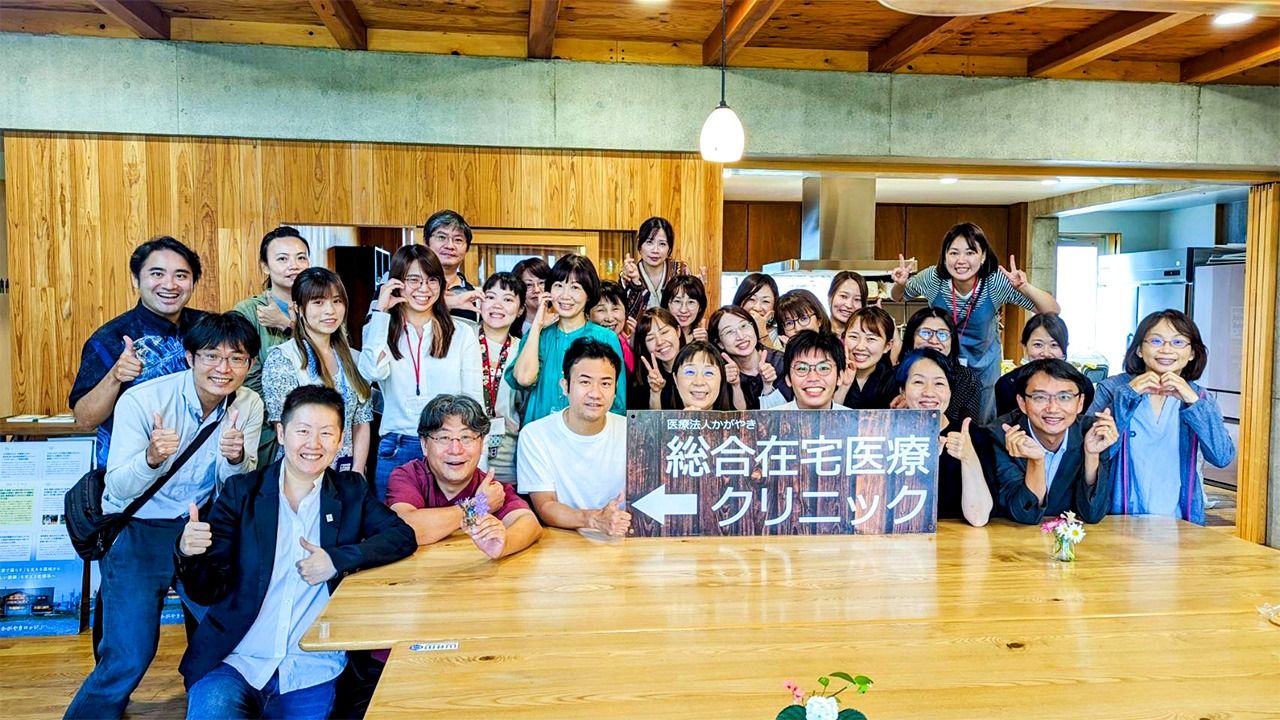
Kagayaki staff and participants at Kagayaki Lodge, June 2023. (© Daidō Atsushi)
(Translated from Japanese. Banner photo: The exterior of Kagayaki Lodge, overflowing with warmth. © Daidō Atsushi.)